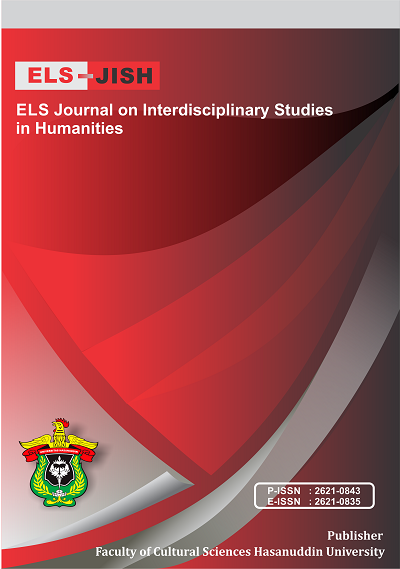Proficient Language Learners’ Perception on the Use of Affective Strategies in Presentation
DOI:
https://doi.org/10.34050/elsjish.v6i3.30793Keywords:
Proficient Language Learners, Presentation, Use of Affective StrategiesAbstract
EFL learners employ various strategies in presentation. Affective strategies help them to give effective presentation in English on any topic. The objective of this study was to find out the most frequently used affective strategies adopted by the proficient learners of the Department of English, Jagannath University, Dhaka, Bangladesh, in their presentation sessions. A mixed-methods approach was used to collect the data in this research. The participants of this research were fourteen (five males and nine females) proficient learners. Oxford’s (1990) SILL (“Strategy Inventory for Language Learning”) questionnaire and interview were used to collect the data. The result showed that the good language learners employed the following affective strategy most frequently to develop their presentation skills: “I encourage myself to speak a foreign language even when I am afraid of making a mistake” (50% ). The next most frequently used strategy was “I talk to someone else about how I feel when I am learning a foreign language” (42.85% ). The third most used strategy was “I notice if I am tensed or nervous when I am studying or using a foreign language” (28.59%). The findings of the research will help learners to develop their presentation skills in English in Bangladesh.
References
Cohen, A. D. (1998). Strategies in Learning and Using a Second Language. London: Longman.
Cohen, A. D. (2000). Exploring Strategies in Test-taking: Fine-tuning Verbal Reports from Respondents. In Ekbatani, G. & Pierson, H. (Eds.), Learner-directed Assessment in ESL (127-150), Mahwah, NJ: Lawrence Erlbaum. Eilers, C. Presentation Skills: Examples & Tips to Improve Yours. Retrieved from https://zety.com/blog/presentation-skills
Indriana, N. R. (2019). Socio-affective Strategies used by the Students to Improve Their English Speaking Skill : A Case Study in Second Semester at Muhammadiyah University of Surakarta (B.Ed. Thesis). Universitas Muhammadiyah Surakarta, Indonesia.
Kosimova, A. (2022). Main Features of Language Learning Strategies. Евразийский журнал академических исследований, 2(12), 1247-1249.
Lai, Y. C. (2009). Language Learning Strategy Use and English Proficiency of University Freshmen in Taiwan. TESOL Quarterly, 43(2), 255-280.
Lestari, M., & Wahyudin, A. Y. (2020). Language learning strategies of undergraduate EFL students. Journal of English Language Teaching and Learning, 1(1), 25-30.
Norah, M. A., & Daniel, B. (2021). Online Engagement During COVID-19: Role of Agency on Collaborative Learning Orientation and Learning Expectations. Journal of Computer Assisted Learning, 37(5): 1285-1295. DOI: 10.1111/jcal.12569
Oxford, R., & Crookall, D. (1989). Research on Language Learning Strategies: Methods, Findings, and Instructional Issues. The Modern Language Journal, 73: 404-419.
Oxford, R. (1990). Language Learning Strategies: What Every Teacher Should Know. New York: Newbury House Publishers.
O’Malley, J. and Chamot, A. (1990). Learning Strategies in Second Language Acquisition. Cambridge: Cambridge University Press.
Pawlak, M., & Oxford, R. L. (2018). Conclusion: The future of research into language learning strategies. Studies in Second Language Learning and Teaching, 8(2), 525-535.
Rahman, F. (2018). The Constraints of Foreign Learners in Reading English Literary Works: A Case Study at Hasanuddin University. Journal of Arts and Humanities, 7(2), 01-12.
Reid, J. M. (1998). Understanding Learning Styles in the Second Language Classroom. Upper Saddle River, NJ: Prentice Hall Regents.
Roboh, A. G. P. & Tedjaatmadja, H. M. (2016). Affective Strategies Used by High Proficiency Learners at Hand Fortuna Center. Kata Kita Journal of Language, Literature, and Teaching, 4(2), 80-85.
Rossiter, M. J. (2003). The effects of affective strategy training in the ESL classroom. Tesl-Ej, 7(2), 1-20. Retrieved from http://www.tesl-ej.org/wordpress/issues/volume7/ej26/ej26a2/
Rubin, J., & Thompson, I. (1982). How to Become a More Successful Language Learner. Boston, MA: Heinle & Heinle.
Vijaya, R. J. (2012). Student's Socio-affective Strategy in Reading. Journal of English and Education, 6(1), 76-100.
Wijirahayu, S. & Dorand, P. (2018). Affective Strategies, Attitudes, and a Model of Speaking Performance Development for Engineering Students. Journal of Physics Conference Series, 948(1): 1-10.
Downloads
Published
Issue
Section
License
Copyright (c) 2023 Tania Tahmina

This work is licensed under a Creative Commons Attribution-ShareAlike 4.0 International License.






